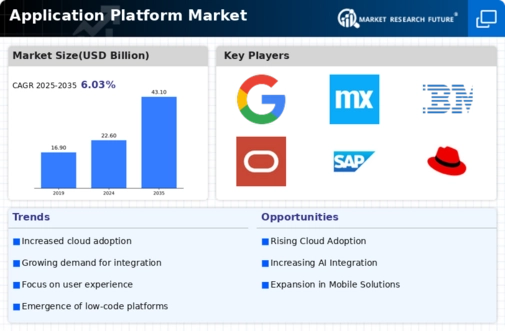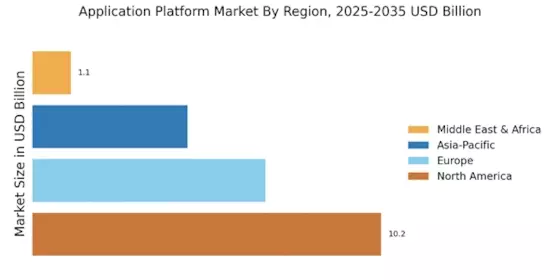Emphasis on Enhanced Security Features
Security remains a paramount concern within the Application Platform Market, particularly as cyber threats continue to evolve. Organizations are increasingly prioritizing platforms that offer robust security features to protect sensitive data and ensure compliance with regulations. Recent statistics reveal that nearly 75 percent of businesses consider security a critical factor when selecting application platforms. This emphasis on security is driving innovation within the industry, as vendors strive to integrate advanced security measures such as encryption, identity management, and threat detection into their offerings. As a result, the Application Platform Market is likely to see a rise in demand for secure application solutions that address these concerns.
Rise of Mobile and Remote Work Solutions
The Application Platform Market is significantly influenced by the rise of mobile and remote work solutions. As organizations increasingly adopt flexible work arrangements, there is a heightened demand for applications that support remote collaboration and productivity. Data indicates that over 50 percent of employees now work remotely at least part-time, necessitating robust application platforms that can facilitate seamless communication and project management. This trend is likely to propel the development of mobile-friendly applications and platforms that cater to the needs of a distributed workforce. The Application Platform Market is thus poised for growth as companies invest in solutions that enhance remote work capabilities.
Increased Demand for Digital Transformation
The Application Platform Market is experiencing a surge in demand driven by the ongoing digital transformation across various sectors. Organizations are increasingly seeking to enhance their operational efficiency and customer engagement through digital solutions. According to recent data, nearly 70 percent of companies are prioritizing digital initiatives, which has led to a significant uptick in the adoption of application platforms. This trend is likely to continue as businesses recognize the necessity of integrating technology into their core processes. The Application Platform Market is thus positioned to benefit from this shift, as companies invest in platforms that facilitate seamless digital experiences and streamline workflows.
Growing Need for Scalability and Flexibility
In the current landscape, the Application Platform Market is witnessing a growing need for scalability and flexibility among enterprises. As businesses expand, they require platforms that can adapt to changing demands and support a diverse range of applications. This need is underscored by the fact that approximately 60 percent of organizations report challenges in scaling their existing IT infrastructure. Consequently, application platforms that offer modular architectures and cloud-native capabilities are gaining traction. The ability to scale resources dynamically not only enhances operational efficiency but also positions companies to respond swiftly to market changes, thereby driving growth within the Application Platform Market.
Integration of Advanced Analytics and Business Intelligence
The Application Platform Market is witnessing a notable trend towards the integration of advanced analytics and business intelligence capabilities. Organizations are increasingly recognizing the value of data-driven decision-making, prompting a demand for platforms that can provide actionable insights. Approximately 65 percent of companies report that they are investing in analytics tools to enhance their operational strategies. This trend is likely to drive the development of application platforms that incorporate analytics features, enabling users to analyze data in real-time and make informed decisions. The Application Platform Market is thus set to benefit from this shift towards data-centric solutions, as businesses seek to leverage analytics for competitive advantage.


















Leave a Comment